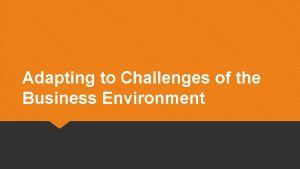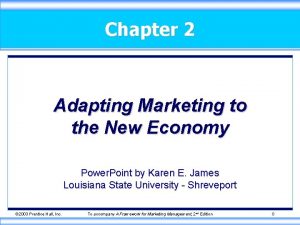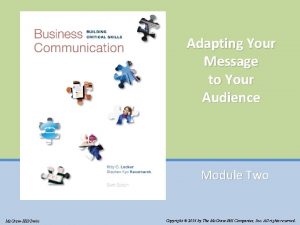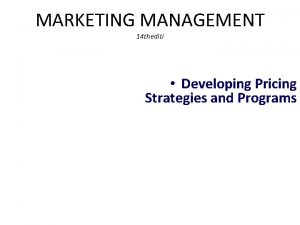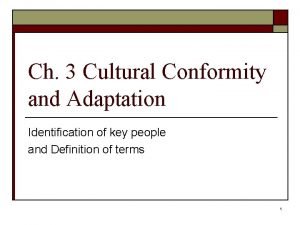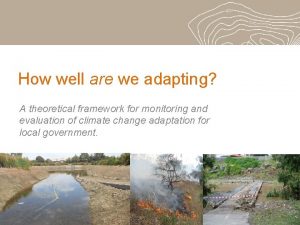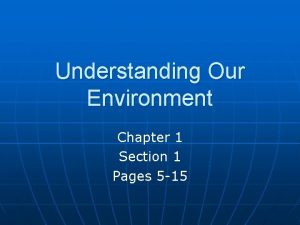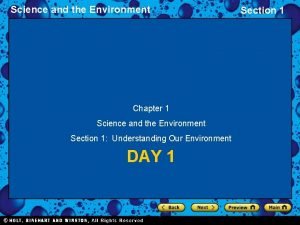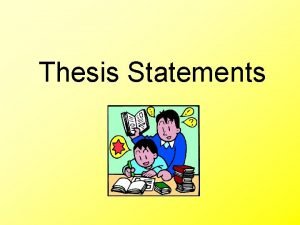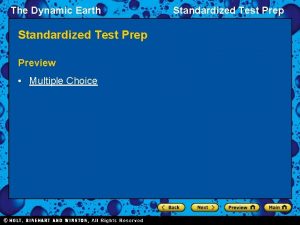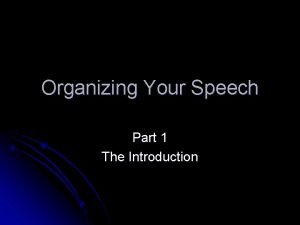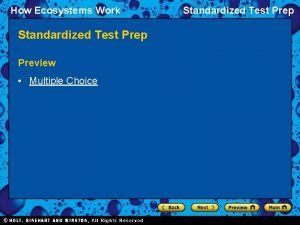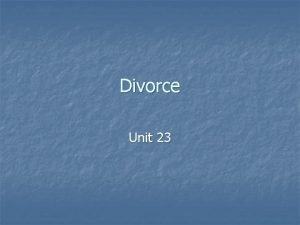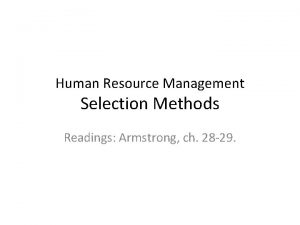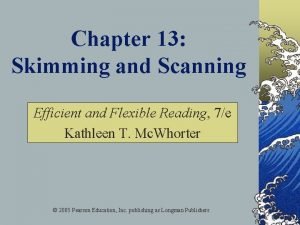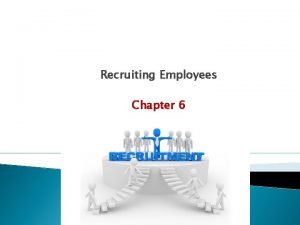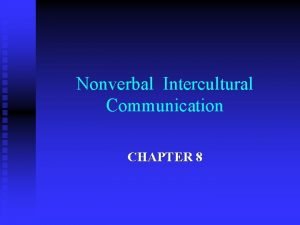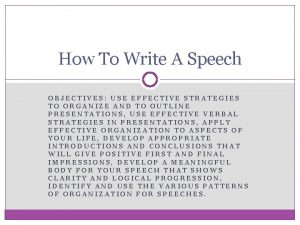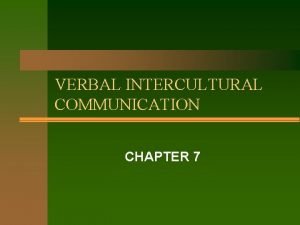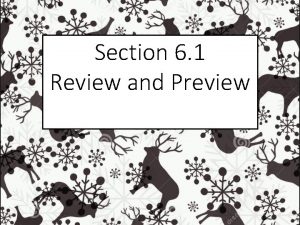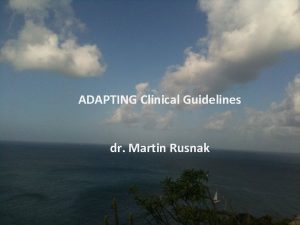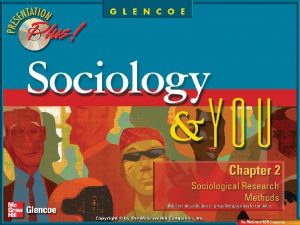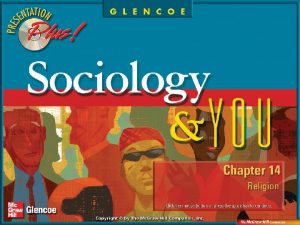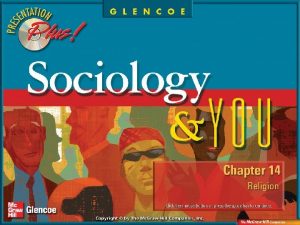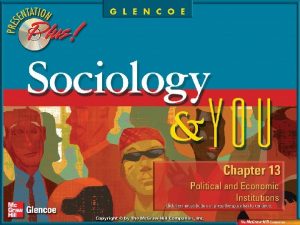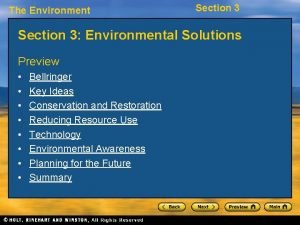Chapter 3 Adapting to the Environment Preview Section










































- Slides: 42

Chapter 3 Adapting to the Environment Preview Section 1 Animal Reproduction Section 2 Plant Reproduction Section 3 Animal Behavior Section 4 Adaptations and Survival Concept Mapping

Chapter 3 Section 1 Animal Reproduction Bellringer Do you know how birds, ants, humans, and sea stars reproduce? Write down any difference that you are aware of in how these animals reproduce. Also, write down any differences that you know of in how these animals raise their young. Write your answers in your science journal.

Chapter 3 Section 1 Animal Reproduction Objectives • Describe the patterns and advantages of asexual reproduction in animals. • Describe the patterns and advantages of sexual reproduction in animals. • Explain how sexual reproduction is related to variation within a species.

Chapter 3 Section 1 Animal Reproduction Objectives, continued • Explain the difference between external and internal fertilization. • Identify the three different types of mammalian reproduction.

Chapter 3 Section 1 Animal Reproduction Asexual Reproduction • In asexual reproduction, a single parent has offspring that are genetically identical to the parent. • Budding, fragmentation, and regeneration are all ways in which a parent organism can produce genetically identical offspring.

Chapter 3 Section 1 Animal Reproduction Sexual Reproduction • In sexual reproduction, offspring are formed when genetic information from more than one parent combines. • Sexual reproduction in animals usually requires two parents—a male and a female. • The female parent produces sex cells called eggs. The male parent produces sex cells called sperm.

Chapter 3 Section 1 Animal Reproduction Sexual Reproduction, continued

Chapter 3 Section 1 Animal Reproduction Internal and External Fertilization • External Fertilization is the process when the sperm fertilizes the eggs outside the female’s body. • Internal Fertilization is the process when the egg and sperm join inside the female’s body.

Chapter 3 Section 1 Animal Reproduction Mammals • Monotremes are mammals that lay eggs. • Marsupials are mammals that give birth to partially developed live young. Most marsupials have pouches where their young continue to develop after birth. • Placental Mammals are nourished inside their mother’s body before birth.

Chapter 3 Section 2 Plant Reproduction Bellringer Brainstorm a list of ways that plants disperse their seeds. Write your answers in your science journal.

Chapter 3 Section 2 Plant Reproduction Objectives • Describe the pattern of sexual reproduction in nonvascular plants. • Describe the pattern of sexual reproduction in seedless vascular plants. • Describe the pattern of sexual reproduction in seed plants. • Identify three kinds of asexual reproduction in plants.

Chapter 3 Section 2 Plant Reproduction in Nonvascular Plants • Nonvascular plants must be covered by a film of water in order for fertilization to occur. • Eggs and sperm form in separate structures, which are often on separate plants. • When water covers the clumps of gametophytes, sperm swim to the female gametophytes and fertilize the eggs.

Chapter 3 Section 2 Plant Reproduction in Seedless Vascular Plants • Similar to nonvascular plants, seedless vascular plants can only reproduce when a film of water covers the gametophyte. • However, in most species of seedless vascular plants, both eggs and sperm are produced on the same plant. • Gametophytes of seedless vascular plants are usually very small and develop on or below the surface of soil.

Chapter 3 Section 2 Plant Reproduction in Seed Plants • Reproduction in Gymnosperms Most gymnosperms have reproductive structures called cones. • Wind transfers pollen from the male cone to the female cone during pollination. • Sperm from pollen fertilize the eggs of the female cone.

Chapter 3 Section 2 Plant Reproduction in Seed Plants, continued • Reproduction in Angiosperms In angiosperms, gametophytes develop within flowers. • Pollination happens when pollen is moved from anthers to stigmas. • Fertilization happens when a sperm fuses with the egg inside an ovule.

Chapter 3 Section 2 Plant Reproduction in Seed Plants, continued

Chapter 3 Section 2 Plant Reproduction in Seed Plants, continued • From Flower to a Fruit After fertilization takes place, the ovule develops into a seed. The seed contains a tiny, undeveloped plant. • As a fruit swells and ripens, it protects the developing seeds. • Fruits often help a plant spread its seeds.

Chapter 3 Section 2 Plant Reproduction in Seed Plants, continued • From Seed to a Plant When seeds are dropped or planted in a suitable environment, the seeds sprout and young plants begin to grow. • To sprout, most seeds need water, air, and warm temperatures. • Each plant species has an ideal temperature at which most of its seeds will begin to grow.

Chapter 3 Section 2 Plant Reproduction in Seed Plants, continued

Chapter 3 Section 2 Plant Reproduction in Seed Plants, continued Other methods of reproduction include: 1. Plantlets Tiny plants grow along the edges of a plant’s leaves. These plantlets fall off and grow on their own. 2. Tubers Underground stems, or tubers, can produce new plants after a dormant season. 3. Runners Above-ground stems from which new plants can grow are called runners.

Chapter 3 Section 3 Animal Behavior Bellringer Write a sentence to describe each of the following terms: predator, prey. List three animals that are predators and three that are prey. Are humans predators or prey? Explain your answer. Write your answers in your science journal.

Chapter 3 Section 3 Animal Behavior Objectives • Explain the difference between learned and innate behavior. • Describe five kinds of behaviors that help animals survive. • Identify seasonal behaviors that help animals adapt to the environment.

Chapter 3 Section 3 Animal Behavior Kinds of Behavior • Innate Behavior that doesn’t depend on learning or experience is known as innate behavior. Innate behaviors are inherited through genes. • Learned Behavior Innate behaviors can be modified. Animals can use learning to change a behavior. Learned behavior is behavior that has been learned from experience or from observing other animals.

Chapter 3 Section 3 Animal Behavior Survival Behavior • Finding Food Animals find food in many ways. Animals that eat other animals are known as predators. The animal being eaten is the prey. • Marking Territory Some animals claim territories to save energy by avoiding this competition. • A territory is an area that is occupied by one animal or by a group of animals that do not allow other members of the species to enter.

Chapter 3 Section 3 Animal Behavior Survival Behavior, continued • Defensive Action Defensive behavior allows animals to protect resources from other animals. Animals defend food, mates, and offspring. • Courtship Animals need to find mates to reproduce. Reproduction is essential for the survival of an individual’s genes. Animals have special behaviors, called courtship, that help them find a mate. • Parenting Many young animals depend on their parents for survival.

Chapter 3 Section 3 Animal Behavior Seasonal Behavior • Migration Many animals avoid cold weather by traveling to warmer places. These animals migrate to find food, water, or safe nesting grounds. • Hibernation is a period of inactivity and decreased body temperature that some animals experience in winter. • Many animals experience a internal slowdown in the hottest part of the summer during a period called estivation.

Chapter 3 Section 3 Animal Behavior Seasonal Behavior, continued • A Biological Clock The internal control of an animal’s natural cycles is called a biological clock. Animals use clues such as the length of the day and the temperature to set their clocks. • Cycles of Change Some biological clocks control long cycles. Seasonal cycles are nearly universal for animals.

Chapter 3 Section 4 Adaptation and Survival Bellringer In your own words, write a definition for the following terms: adaptation, natural selection, and competition. Write your definitions in your science journal.

Chapter 3 Section 4 Adaptation and Survival Objectives • Identify three kinds of adaptations that help organisms survive. • Describe the four parts of natural selection. • Explain how variation occurs within a population.

Chapter 3 Section 4 Adaptation and Survival Objectives, continued • Explain why genetic variation within a population is important. • Explain how resistance to insecticide is a survival characteristic.

Chapter 3 Section 4 Adaptation and Survival Adaptations for Obtaining Food • An adaptation is a characteristic that improves an individual’s ability to survive and reproduce in a particular environment. • Almost all organisms have adaptations to help them obtain food.

Chapter 3 Section 4 Adaptation and Survival Predator-Prey Adaptations • Many organisms also have adaptations that serve as a defense against predators. • One common adaptation that helps predators and prey is called camouflage. An organism that is camouflaged is disguised so that it is hard to see even when the organism is in view.

Chapter 3 Section 4 Adaptation and Survival Adaptations to Interactions • Two species can also acquire adaptations because of their interaction with one another. • Adaptations because of interactions can take place between any organisms that live close together.

Chapter 3 Section 4 Adaptation and Survival Natural Selection • Inherited characteristics in populations can change over time. • Natural selection is the process by which individuals that are better adapted to their environment survive and reproduce more successfully than less well-adapted individuals do.

Chapter 3 Section 4 Adaptation and Survival Natural Selection, continued • The theory of natural selection explains how a population changes in response to its environment. • If natural selection is always taking place, a population will tend to be well adapted to its environment. • The individuals that are likely to survive and reproduce are those that are best adapted at the time.

Chapter 3 Section 4 Adaptation and Survival Natural Selection, continued

Chapter 3 Section 4 Adaptation and Survival Changes in Genetic Variation • In order for natural selection to continue, individuals within the population must be different. • Over time, the population will be made up of more individuals with characteristics that help them survive. • If a population decreases rapidly, a genetic bottleneck occurs. Many characteristics may be lost entirely from a population because all of the individuals with those characteristics died.

Chapter 3 Section 4 Adaptation and Survival

Chapter 3 Section 4 Adaptation and Survival Insecticide Resistance • Insecticide resistance is also a result of natural selection. • Some individual insects within a population are resistant to certain insecticides. Resistance is an adaptation. • These insects survive and reproduce. They pass the insecticide-resistance genes to their offspring.

Chapter 3 Adapting to the Environment Concept Mapping Use the terms below to complete the concept map on the next slide. asexual reproduction external fertilization reproduction sexual reproduction budding fragmentation internal fertilization

Chapter 3 Adapting to the Environment

Chapter 3 Adapting to the Environment
 Adapting to challenges of the micro environment
Adapting to challenges of the micro environment How well are we adapting
How well are we adapting How to adapt marketing to the new economy
How to adapt marketing to the new economy What is adopting materials
What is adopting materials 'adapting the message to your audience
'adapting the message to your audience Adapting the price
Adapting the price The process of adapting borrowed cultural traits.
The process of adapting borrowed cultural traits. Adapting the price
Adapting the price Audience analysis example
Audience analysis example How well are we adapting
How well are we adapting Adapting curriculum to bridge equity gaps
Adapting curriculum to bridge equity gaps Chapter 1 section 1 understanding our environment answers
Chapter 1 section 1 understanding our environment answers Chapter 1 science and the environment section 2
Chapter 1 science and the environment section 2 Working thesis example
Working thesis example Summary of thesis statement
Summary of thesis statement Test prep preview
Test prep preview Test prep preview
Test prep preview Test prep preview
Test prep preview Test prep preview
Test prep preview Sccm technical preview
Sccm technical preview Startling statement introduction examples
Startling statement introduction examples What is a preview statement
What is a preview statement Test prep preview
Test prep preview Nnn preview
Nnn preview The selection preview
The selection preview Chapter 21 standardized test practice answers
Chapter 21 standardized test practice answers The four agreements preview
The four agreements preview Test prep preview
Test prep preview Line between pada perintah column digunakan untuk membuat
Line between pada perintah column digunakan untuk membuat Classic trio' of selection techniques
Classic trio' of selection techniques Test prep preview
Test prep preview Disadvantages of skimming reading
Disadvantages of skimming reading 1984 book preview
1984 book preview Yandex.ru video
Yandex.ru video Nút lệnh print preview nằm ở đâu
Nút lệnh print preview nằm ở đâu Tams ut austin
Tams ut austin Review and preview
Review and preview Realistic job preview pros and cons
Realistic job preview pros and cons Disadvantages of realistic job preview
Disadvantages of realistic job preview Preview of main points
Preview of main points Preview speech
Preview speech Preview of main points
Preview of main points Nnn image preview
Nnn image preview
